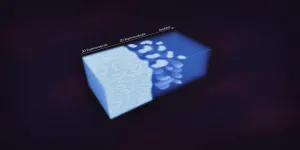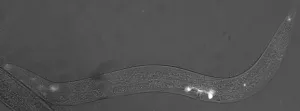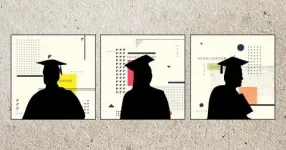(Press-News.org) Cows don't seem to have a whole lot going on most of the time. They're raised to spend their days grazing in the field, raised for the purpose of providing milk or meat, or producing more cows. So when students in UC Santa Barbara ecologist Doug McCauley's lab found themselves staring intently at satellite image upon image of bovine herds at Point Reyes National Seashore, it was funny, in a "Far Side" kind of way.
"There were about 10 undergrads involved in the project, spotting cows from space -- not your typical student research and always amusing to see in the lab," McCauley said. They became proficient at discerning the top view of a cow from the top view of rocks or the top view of other animals, he added.
"After about eight months, we ended up with more than 27,000 annotations of cattle across 31 images," said Lacey Hughey, an ecologist with the Smithsonian Conservation Biology Institute who was a Ph.D. student in the McCauley Lab at the time, and the leader of the cow census. "It took a long time."
All of the rather comical cow counting had a serious purpose, though: to measure the interactions between wildlife and livestock where their ranges meet or overlap. Roughly a third of the United States' land cover is rangeland, and where these grazing areas abut wildland, concerns over predation, competition and disease transmission are bound to arise.
Such is the case at Point Reyes National Seashore, a picturesque combination of coastal bluffs and pastureland about an hour's drive north of San Francisco. As part of a statewide species restoration plan, native tule elk were reintroduced to the park's designated wilderness area in the 1990s, but they didn't stay in their little corner of paradise for very long.
"Some of them actually ended up swimming across an estero and establishing this herd -- which is known as the Drake's Beach Herd -- near the pastoral zone of the park, which is leased to cattle ranchers," said Hughey, the lead author of a collaborative study with the University of Nevada, Reno, that appears in the journal Biological Conservation. Cattle fences don't stop elk either, she said; they can easily cross or break through them to enter pastures. The situation was also somewhat unique in that the Drake's Beach elk live in the area year-round, thanks in large part to the stable climate, so grazing pressure on the land is constant.
Where's the beef?
"So we were wondering, how do elk and cattle co-exist in this landscape?" Hughey said. "The story between elk and cattle is actually pretty complex. We know from other studies that elk and cattle can be competitors, but they can also be facilitators. We also didn't know very much about which habitats elk preferred in this part of the park and how the presence of cattle might influence an elk's decision to spend its time in one place over another."
The researchers set out to answer these questions with two large datasets generated by the park -- GPS monitoring data from collared elk, and field-based transect surveys of the elk. What was missing, however, was information on the cows.
"We knew quite a bit about where the elk were, but we didn't have any information about where the cows were, except that they were inside the fences," she said. Knowing the precise number and location of cows relative to the elk herd would be necessary to understand how both species interact in a pastoral setting.
"Because the elk data was collected in the past, we needed a way to obtain information on cattle populations from the same time period. The only place we could get that was from archived, high-resolution satellite imagery," Hughey said. Hence, the satellite cowspotting.
Their conclusion? Elk have acclimated to cattle at Point Reyes by avoiding cow pastures in general and by choosing separate foraging sites on the occassions that they co-occur. Taken together, these findings suggest that elk select habitat in a manner "that reduce[s] the potential for grazing conflicts with cattle, even in cases where access to forage is limited."
In addition to helping shed light on the ecological relationship between cows and tule elk at Point Reyes, satellite imaging can also define their areas of overlap -- an important consideration in the assessment of disease risk, the researchers said.
"There's a disease of concern that's been found in the elk herd and also in the cattle, called Johne's disease," Hughey said. The bacteria that cause it can persist in the environment for more than a year, she added, so even though cows and elk rarely share space at the same time, there is still a theoretical risk of transmission in this system.
Sharing space
According to the researchers, the satellite imaging technique is also widely applicable to other areas on the globe where livestock and wildlife ranges overlap.
"The issue of livestock and wildlife being in conflict is a major challenge in a bunch of different contexts in the U.S. and beyond," McCauley said. "It has been surprisingly hard to figure out exactly how these wild animals share space with domestic animals."
These new methods, he said, "will have a transformative impact on understanding how livestock use wildlands -- and how wildlife use grazing lands."
Next stop: Kenya and Tanzania.
Working with the National Geospatial Intelligence Agency, Microsoft AI for Good, University of Glasgow, and University of Twente -- and thanks in large part to the data generated by those cow-tracking UC Santa Barbara undergrads -- Hughey and colleagues are training an algorithm to detect and identify animals in the plains of East Africa, such as wildebeest and, of course, cows.
INFORMATION:
Research in the paper was also contributed by Kevin T. Shoemaker and Kelley M. Stewart at the University of Nevada and J. Hall Cushman at the Smithsonian Institution
Creating a two-dimensional material, just a few atoms thick, is often an arduous process requiring sophisticated equipment. So scientists were surprised to see 2D puddles emerge inside a three-dimensional superconductor - a material that allows electrons to travel with 100% efficiency and zero resistance - with no prompting.
Within those puddles, superconducting electrons acted as if they were confined inside an incredibly thin, sheet-like plane, a situation that requires them to somehow cross over to another dimension, where different rules of quantum physics apply.
"This is a tantalizing example of emergent behavior, which is often difficult or impossible to replicate by trying to engineer it from scratch," said Hari Manoharan, a professor at Stanford University and investigator ...
When Iranian authorities started seizing Barbie dolls from Tehran toy shops in 2012, Mattel Inc. execs faced concerns not only about the dolls' attire -- miniskirts and swimsuits considered immodest in an Islamic country -- but also questions from the U.S. Securities and Exchange Commission (SEC) about Mattel's ties to Iran.
U.S. businesses are restricted from business in Iran, which U.S. authorities have designated a state sponsor of terrorism (SST). The number of SEC inquiries about potential terrorist ties has grown substantially in recent years, and according to new research from Duke University's Fuqua School of Business, the increase could reduce the quality of the agency's financial reporting oversight.
"Comments on terrorism are getting to a critical level of importance ...
Really big systems, like ocean currents and weather, work on really big scales. And so too does your plastic waste, according to new research from Janice Brahney from the Department of Watershed Sciences. The plastic straw you discarded in 1980 hasn't disappeared; it has fragmented into pieces too small to see, and is cycling through the atmosphere, infiltrating soil, ocean waters and air. Microplastics are so pervasive that they now affect how plants grow, waft through the air we breathe, and permeate distant ecosystems. They can be found in places as varied as the human bloodstream to ...
To maximise absorption of nutrients from the diet, the intestinal mucous membrane has a large surface area. However, this also makes it vulnerable to attack from aggressive gut microbes. A new study by Uppsala University researchers now shows that the surface layer of the mucosa, known as the epithelium, can rapidly contract when it recognises a bacterial attack. The results are published in the journal PNAS.
Every year, hundreds of millions of people worldwide suffer from bacterial gut infections of one kind or another, which are often hard to treat. Antibiotics can kill the normal flora of the intestine, ...
Researchers at the University of British Columbia have discovered three liquid phases in aerosol particles, changing our understanding of air pollutants in the Earth's atmosphere.
While aerosol particles were known to contain up to two liquid phases, the discovery of an additional liquid phase may be important to providing more accurate atmospheric models and climate predictions. The study was published today in PNAS.
"We've shown that certain types of aerosol particles in the atmosphere, including ones that are likely abundant in cities, can often have three distinct liquid phases." says ...
Using laboratory-grown roundworms as well as human and mouse eye tissue, University of Maryland School of Medicine (UMSOM) researchers have identified a new potential mechanism for age-related macular degeneration--the leading cause of blindness among older adults. The UMSOM researchers say that the findings suggest a new and distinct cause that is different from the previous model of a problematic immune system, showing that the structural organization of the eye's light-detecting cells may be affected by the disease.
The discovery offers the potential to identify new molecular targets to treat the disease. Their discovery was published on April 12 in the Proceedings of the National Academy of Sciences (PNAS).
According to the National Eye Institute, ...
PRINCETON, N.J.--Increasing diversity remains a key priority at universities, especially in the wake of mass demonstrations in support of racial equality in 2020 following the death of George Floyd. Many universities are guided by the motivation that diversity enhances student learning, a rationale supported by the U.S. Supreme Court.
This approach, however, is a view preferred by white and not Black Americans, and it also aligns with better relative outcomes for white Americans, according to a paper published by Princeton University researchers in the Proceedings of the National Academy of Sciences.
Across eight studies including 1,200 participants, the researchers looked at two different approaches to diversity: an "instrumental rationale," which asserts that including ...
BOSTON - Many patients with cancer receive immune checkpoint inhibitors that strengthen their immune response against tumor cells. While the medications can be life-saving, they can also cause potentially life-threatening side effects in internal organs. This double-edged sword makes it challenging for clinicians to decide who should be considered candidates for treatment. A new analysis led by researchers at Massachusetts General Hospital (MGH) indicates which patients are at elevated risk of side effects severe enough to require hospitalization. The findings are published in the END ...
BOSTON - Immune checkpoint inhibitors, which boost the immune system's response against tumor cells, have transformed treatment for many advanced cancers, but short-term clinical trials and small observational studies have linked the medications with various side effects, most commonly involving the skin. A more comprehensive, population-level analysis now provides a thorough look at the extent of these side effects and provides insights on which patients may be more likely to experience them. The research was led by investigators at Massachusetts General ...
Abstract #LB008
HOUSTON -- A preclinical study led by researchers at The University of Texas MD Anderson Cancer Center shows an antibody-drug conjugate (ADC) targeting surface protein MT1-MMP can act as a guided missile in eradicating osteosarcoma tumor cells without damaging normal tissues. This technology, using precision therapy targeting of cell-surface proteins through a Bicycle toxin conjugate (BTC), shows encouraging results for the treatment of osteosarcoma.
Findings from the study were presented today by Yifei Wang, M.D., a postdoctoral fellow of Pediatrics Research, at the virtual ...




